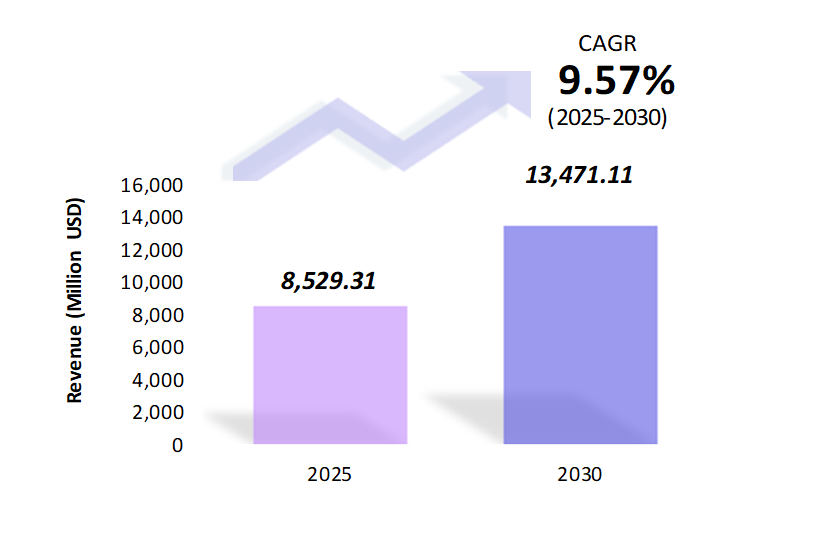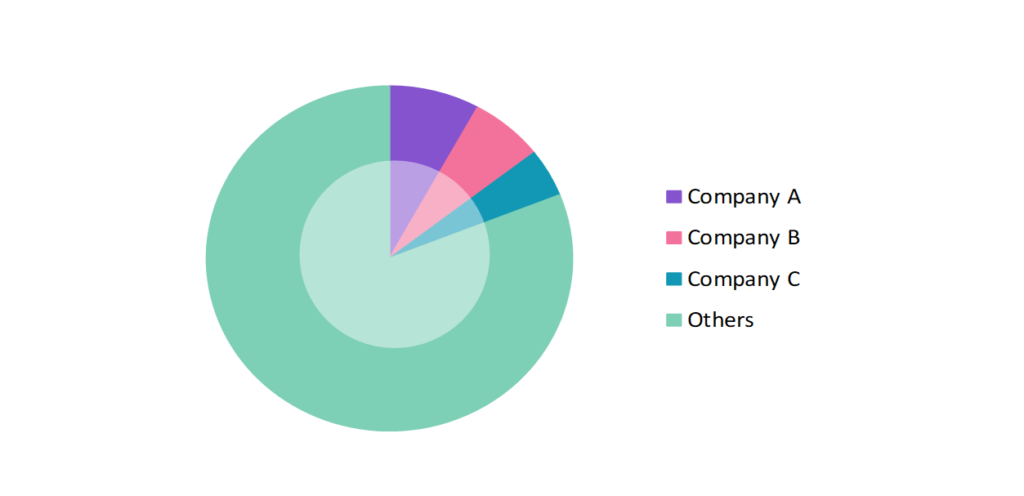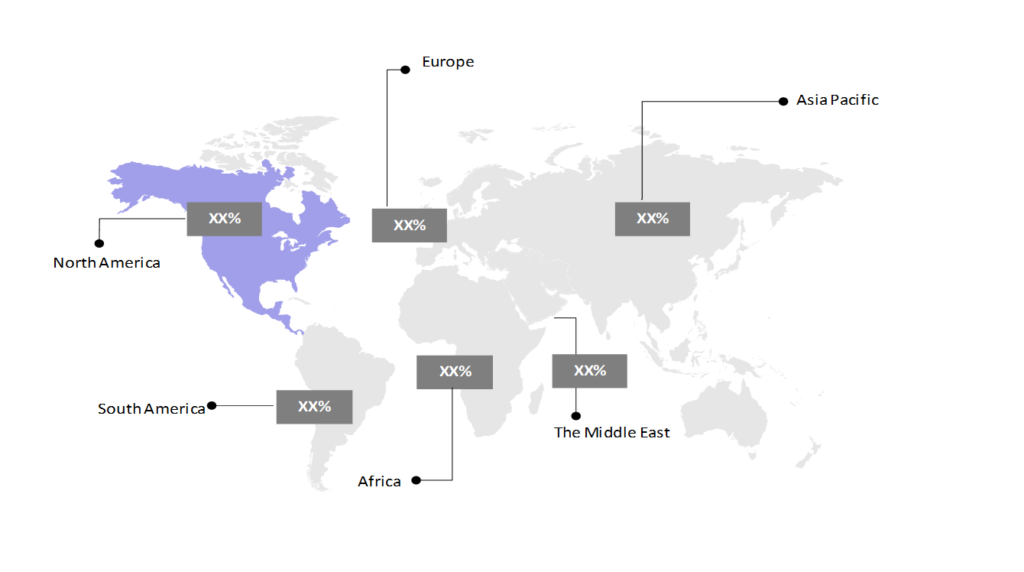Popcorn Market Insights: Size, Share, Growth Analysis & Forecast (2024-2029)
The market report offers a detailed analysis segmented by Type (Microwave Popcorn, Ready-to-Eat (RTE) Popcorn); by Distribution Channel (Hypermarkets/Supermarkets, Convenience Stores, Online Retail Stores, Others); by Geography (North America, South America, Asia Pacific, Europe, The Middle East, Africa).
Outlook

- The popcorn market is estimated to be at USD 8,529.31 Mn in 2025 and is anticipated to reach USD 13,471.11 Mn in 2030.
- The popcorn market is registering a CAGR of 9.57% during the forecast period 2025-2030.
- The popcorn market is growing steadily, driven by increasing demand for healthier snack options and innovative flavor profiles. Ready-to-eat popcorn products have gained popularity due to their convenience, aligning with modern on-the-go lifestyles. Sustainability in packaging and clean-label ingredients are becoming critical factors that appeal to environmentally conscious consumers. However, challenges like rising raw material costs and intense competition present obstacles for market players.
Request a free sample.
Ecosystem

- The participants in the global popcorn industry are always developing their strategies to preserve a competitive advantage.
- Companies compete by innovating with unique flavors, functional ingredients, and healthier processing methods, aiming to attract health-conscious consumers and stand out in a crowded market.
- Several important entities in the popcorn market include Campbell Soup Co.; PepsiCo, Inc.; Weaver Popcorn Co.; The Hershey Co.; Quinn Foods LLC; and others.
Ask for customization.
Findings
| Attributes | Values |
|---|---|
| Historical Period | 2019-2023 |
| Base Year | 2024 |
| Forecast Period | 2025-2030 |
| Market Size (2025) | USD 8,529.31 Mn |
| Market Size (2030) | USD 13,471.11 Mn |
| Growth Rate | 9.57% CAGR from 2025 to 2030 |
| Key Segments | Type (Microwave Popcorn, Ready-to-Eat (RTE) Popcorn); Distribution Channel (Hypermarkets/Supermarkets, Convenience Stores, Online Retail Stores, Others); Geography (North America, South America, Asia Pacific, Europe, The Middle East, Africa) |
| Key Vendors | Campbell Soup Co.; PepsiCo, Inc.; Weaver Popcorn Co.; The Hershey Co.; Quinn Foods LLC |
| Key Countries | The US; Canada; Mexico; Brazil; Peru; Colombia; Chile; China; India; Japan; South Korea; The UK; Germany; Italy; Spain; Turkey; UAE; Saudi Arabia; Egypt; South Africa |
| Largest Market | North America |
Get a free quote.
Trends
- Development of Functional and Health-Enhanced Popcorn: Companies are adding nutritional benefits, such as high-fiber, protein, and antioxidant-rich ingredients, to create a healthier snacking experience. Popcorn infused with vitamins, minerals, and superfoods like spirulina or turmeric has gained traction, catering to consumers looking for functional snacks. LesserEvil’s Organic Popcorn offers popcorn varieties that incorporate superfoods and health-boosting ingredients, like Himalayan pink salt, coconut oil, and organic avocado oil.
- Unique Flavors and Culinary Fusion: Innovation in flavor profiles is a significant trend, with brands introducing options like matcha, truffle, seaweed, and even dessert flavors like chocolate and caramel drizzle. These unique flavors cater to adventurous eaters and encourage culinary creativity, which makes popcorn a more gourmet snack.
- Sustainable and Eco-Friendly Packaging: With a growing focus on sustainability, popcorn brands are using biodegradable, compostable, or recyclable packaging materials. This not only appeals to environmentally conscious consumers but also aligns with global initiatives to reduce plastic waste in the food industry. Quinn Snacks brand uses compostable, recyclable, and biodegradable packaging for their microwave popcorn products. Their packaging eliminates the use of chemical coatings, such as plastic or PFAS (per- and polyfluoroalkyl substances), commonly found in traditional microwave popcorn bags.
Speak to analyst.
Catalysts
- Shift toward Convenient and On-the-Go Snacks: The modern lifestyle prioritizes convenience, which makes ready-to-eat popcorn an appealing snack choice. Pre-popped and portioned popcorn options meet the demand for grab-and-go snacking, especially among busy consumers looking for healthier alternatives to chips and other processed snacks. SkinnyPop offers pre-popped popcorn in various flavors, all portioned in single-serve bags and family-size options. Their products cater to consumers seeking a healthier, on-the-go snack, as they are made without artificial ingredients, preservatives, or GMOs.
- Expansion of E-commerce and Direct-to-Consumer Channels: The rise of online shopping has made it easier for niche and specialty popcorn brands to reach a wider audience. E-commerce platforms and subscription models allow consumers to explore and purchase unique popcorn varieties conveniently, which drives growth and brand visibility.
- Increased Popularity of Home Entertainment: As more people embrace at-home entertainment, especially following recent global shifts in lifestyle, demand for popcorn as a home snack has increased. Popcorn is often associated with movie nights and social gatherings, which makes it a popular choice for consumers spending more time at home.
Inquire before buying.
Restraints
- Rising Raw Material Costs: The price volatility of corn and other essential ingredients, such as oils and natural seasonings, can impact production costs. This fluctuation affects profit margins, especially for small or niche popcorn brands that focus on organic and high-quality ingredients, often resulting in higher retail prices.
- Health Concerns Related to Additives: While many brands are focusing on healthier ingredients, some popcorn products still use artificial flavors, preservatives, and unhealthy oils. Increased consumer awareness around these ingredients is creating pressure on brands to reformulate, which can be costly and affect taste and shelf life.
- Regulatory Challenges: Regulations around food labeling, especially for health claims and organic certification, are stringent. Popcorn brands that want to market their products as organic, non-genetically Modified Organisms (GMO), or free from certain allergens face rigorous testing, certification processes, and costs associated with compliance. Smaller brands often struggle to adopt eco-friendly packaging due to these costs, which may limit their appeal to environmentally-conscious consumers.
Personalize this research.
Hotspot

Explore purchase options.
Table of Contents
| 1. Introduction 1.1. Research Methodology 1.2. Scope of the Study 2. Market Overview / Executive Summary 2.1. Global Popcorn Market (2019 – 2023) 2.2. Global Popcorn Market (2024 – 2030) 3. Market Segmentation 3.1. Global Popcorn Market by Type 3.1.1. Microwave Popcorn 3.1.2. Ready-to-Eat (RTE) Popcorn 3.2. Global Popcorn Market by Distribution Channel 3.2.1. Hypermarkets/Supermarkets 3.2.2. Convenience Stores 3.2.3. Online Retail Stores 3.2.4. Others 4. Regional Segmentation 4.1. North America 4.1.1. The US 4.1.2. Canada 4.1.3. Mexico 4.2. South America 4.2.1. Brazil 4.2.2. Peru 4.2.3. Colombia 4.2.4. Chile 4.2.5. Rest of South America 4.3. Asia Pacific 4.3.1. China 4.3.2. India 4.3.3. Japan 4.3.4. South Korea 4.3.5. Rest of Asia Pacific 4.4. Europe 4.4.1. The UK 4.4.2. Germany 4.4.3. Italy 4.4.4. Spain 4.4.5. Rest of Europe 4.5. The Middle East 4.5.1. Turkey 4.5.2. UAE 4.5.3. Saudi Arabia 4.5.4. Rest of the Middle East 4.6. Africa 4.6.1. Egypt 4.6.2. South Africa 4.6.3. Rest of Africa 5. Value Chain Analysis of the Global Popcorn Market 6. Porter Five Forces Analysis 6.1. Threats of New Entrants 6.2. Threats of Substitutes 6.3. Bargaining Power of Buyers 6.4. Bargaining Power of Suppliers 6.5. Competition in the Industry 7. Trends, Drivers and Challenges Analysis 7.1. Market Trends 7.1.1. Market Trend 1 7.1.2. Market Trend 2 7.1.3. Market Trend 3 7.2. Market Drivers 7.2.1. Market Driver 1 7.2.2. Market Driver 2 7.2.3. Market Driver 3 7.3. Market Challenges 7.3.1. Market Challenge 1 7.3.2. Market Challenge 2 7.3.3. Market Challenge 3 8. Opportunities Analysis 8.1. Market Opportunity 1 8.2. Market Opportunity 2 8.3. Market Opportunity 3 9. Competitive Landscape 9.1. Campbell Soup Co. 9.2. PepsiCo, Inc. 9.3. Weaver Popcorn Co. 9.4. The Hershey Co. 9.5. Quinn Foods LLC 9.6. Company 6 9.7. Company 7 9.8. Company 8 9.9. Company 9 9.10. Company 10 |
Know the research methodology.
Popcorn Market – FAQs
1. What is the current size of the popcorn market?
Ans. In 2025, the popcorn market size is USD 8,529.31 Mn.
2. Who are the major vendors in the popcorn market?
Ans. The major vendors in the popcorn market are Campbell Soup Co.; PepsiCo, Inc.; Weaver Popcorn Co.; The Hershey Co.; Quinn Foods LLC.
3. Which segments are covered under the popcorn market segments analysis?
Ans. The popcorn market report offers in-depth insights into Type, Distribution Channel, and Geography.
